 Medieval Siege Warfare
Medieval Siege Warfare
 Medieval Siege Warfare
Medieval Siege Warfare


people have visited this site since August 25, 1998.
| The castles | Pictures and links |
1.0 Introduction : One thousand years ago, Europe was constantly under attack By the Vikings, the Arabians and the Hungarians. The kings alone could not fend off such forces with their armies alone, so they gave lands to their nobles all over the country to protect it in an eventual attack. On their lands, the nobles built wooden towers on high ground and surrounded them with dry moats. If the terrain was flat, a hill was built. As the attack evolved, so did the castles. The castles offered excellent protection to the nobles, their armies and to the peasants for weeks if not months in the event of a siege. Siege warfare was more common in the middles ages than straight out battles. Major invasions were concentrated on castles rather than land. How did medieval castles and war methods adapt to siege warfare?
2.0 The defense : The best defense of a castle was in it's position, it's shape and it's design. The site was very important because natural formations could be used to the advantage of the defense. As the siege engines developped, the shape became more important. Small changes could offer immense advantages : Walls were added and the moats filled with water.
2.1 The site : The site of a castle was allways chosen very carefully by the architects. The ideal site was high on a cliff with water at the base. This limited the approach possibilities of the attacker. The wall guards could thus see an approaching army miles away. The "ch�teau Gaillard and Monsegur are excellent examples.
 ,,
,,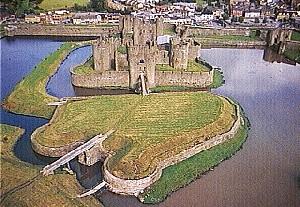
2.2 The shape : Slowly, the castles evolved to better protect those inside. After the constuction of a wooden tower and a wall, was the addition of a giant stone tower, called keep. The keep, often at least 11 meters high, had a square base and thick walls was the last line of defense of a castle. Soon, though, the square keep revealed it's major disadvantage. The archers could not get a good shot at the base without exposing themselves to intense ennemi fire. The attackers used this to their advantage and broke the wall at the corners. The best way to prevent this, was to build a round tower, from witch the archers had no blind spots. The best castles of the time had several walls and a very large moat.

2.3 The design : At first, the walls were simple, and offered few advantages. This was resolved after the first crusade, when the knights returned with many new ideas about castle constuction. Particularily, towers at regular intervals along the wall, machicolations, covered parapet walks, and crenels and merlos along the wall. The machicolations are a horizontal extension at the top of the wall with a grated floor from whitch hot oils or liquids, rocks or even arrows could be dropped. The wall was also much thicker at the base tah at the top, this way when objects were dropped from the top they were deflected towards the outside.
 ,,
,,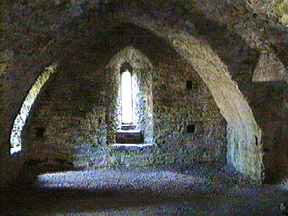
In the 12th century the wall towers were improved : each was independant and close to each others so as to help each other in battle. In such a way, one part of the wall could be occupied by the ennemy and the rest would be in friendly hands. The Spanish also took this idea a little further and placed the towers completly off the wall and connected by a high wooden bridge. Thet were called "torres aldabarranas" and were very effecient, though expensive. The torres albarranas didn't have much succes in the rest of Europe but there are a couple of castles with such towers in France and England. These towers were practically keeps, and the castles almost untakable. Another idea was to use towers as strategic points, but not independant ones. Called towers open at the throat weren't protected on the inside of the castle. Any attacker coming into the tower was un-protected. The floor could sometimes be removed rendering the tower useless to the ennemy.

2.4 The doorway : The only part creating a big problem to the architects was the doorway. It had to be built on flat terrain to allow the passages of horses or carts. The easiest way to do this was to build a tower on the left side of the door, from the inside of the castle, to leave the unprotected side of the soldiers. Another method was to have the door pass right through a tower. This way, depending on the exact design, an attackers was shot at from above and his two sides. Another good design was to make the doorway go between to towers linked from above. If these towers were deep, there was room for up to three wrought iron gates.The more room on the inside, the more sophisticated the draw-bridge. At the time, the best bridge pivoted in the middle with a moat on the outside and a dry moat on the inside.
 ,,
,,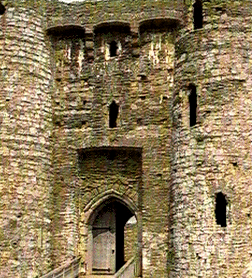 ,,
,,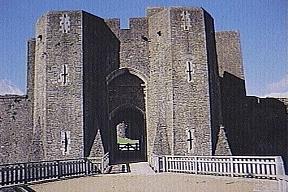 ,,
,,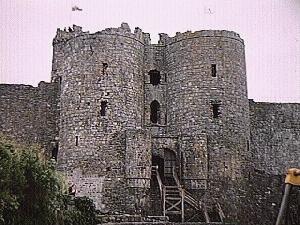
3.0 The attack : In the middle ages there were several ways to take a castle. One way was to break the wall and to hope the people inside would surrender. Sometimes effecient but wasted the wall.
When a castle was not at war, it was normally badly protected, and vulnerable to a surprise attack. In 1341 the scottish took Edinburgh castle in such a way. This also worked if there was a traitor inside the castle who would open the door for a fee. The most popular way was to lay siege to the castle. An army would surround it and deny all contact with the outside. They waited until the defenders gave up or until the well was dry. A siege was easy for neither party. It was a period of insecurity on the inside because of the risk of plague or poisoned water. And the stagnant conditions on the outside also were under the threat of sickness or from another army comming to the aid of the castle.
3.1 Techniques : During a siege, both armies were constantly under attack of varied objects. Sometimes, dead animals or even spies discovered on one side were launched over the wall. This was a primitive form of biological warfare. All around the castle various installaions were built. Small personal walls were constructed for the archers who tried to decimate the defenders. If a ram was used to break the door, a pent-house was built, this is a kind of shelter under which the door can be broken in relative safety. Sometimes, a pendulum was built to swing the ram, making it much more effecient. This was used mainly during the square base years.
Sometimes, if the earth permitted, a mine was built under the wall and held up with wooden beams. The mine was then filled with combustibles and set ablaze. when the beams gave way the wall crumbled. The only protection against such an attack was do dig towards the ennemi and have an underground battle.
Another way to get over the wall was to build a large siege tower. Siege towers are made of wood and placed on wheels. Slightly taller than the stone walls, they were covered with wet furs to render them fire proof. In the most extravagant cases, a catapult was built on the roof. To place the tower adjacent to the outer skirt, the moat had to be filled with dirt or wood. A bridge then connected the tower to the wall.
3.2 Catapults, trebuchets and ballistas : The catapult was very popular during sieges in the middle ages. It could throw a rock up to a hundred meters away with relative accuracy. Working on the base of tension, the catapult is still used today, though for completly different reasons.

The trebuchet is the only siege engine invented in the middle ages. It consists of a large beam with a heavy weight on one end and a sling ont the other. Vertical beams held it up on a specific point. The trebuchet uses gravity to launch large objects hundreds of meters.
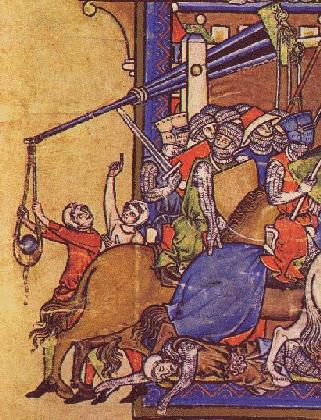 ,,
,,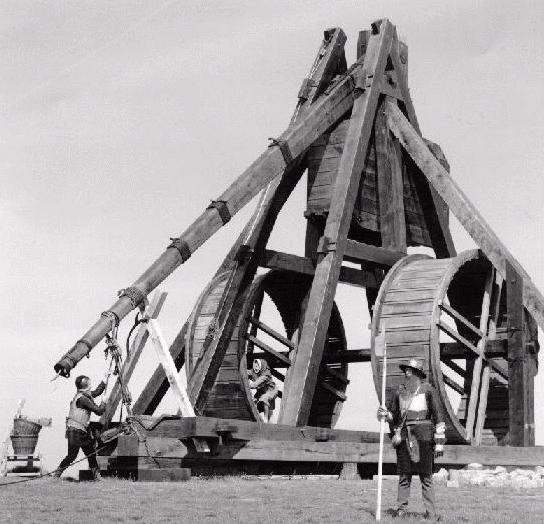 ,,
,,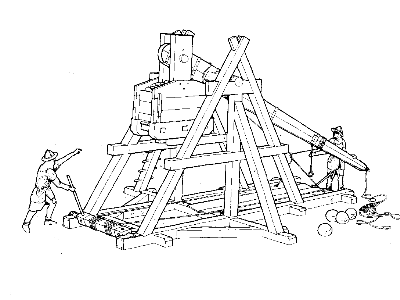
A ballista is a giant cross-bow invented by the romans. It usually lauches bolts 300 to 400 meters away. At point blank these bolts could pierce several men. Being very precise, the ballista was used to set fire on ennemi castles D�tails sur les photos
4.0 Conclusion : The evolution of the castle was certainly influenced by the advancements in the siege engines. For more than 300 years castles were the strength of a nation. A small army in a good castle could fend off much larger armies for extended periods of time. Odiham castle, guarded by 3 knights and 10 sergeants held off an army of 7000. In the 15th century though, the siege engines finally surpassed the castles. Canons could destroy in hours what the conventional siege engines did in months.
5.0 Bibliography
1. Forts and Fortresses, Brice, Martin.Quarto publishing, U.S.A.1990.
2. La France des Chateaux forts, Geo, France, Avril 1993
3. Encyclopeadia Britanica, Tome 4, Encyclopeadia Britannica,U.S.A. 1969.
4. Encyclopeadia Britanica, Tome 8, Encyclopeadia Britannica,U.S.A. 1969.
5. Medieval Castle, ADAM, Brian, Aladdin Books ltd, 1989.
6. Castles, SMITH, BethFranklin Watts, 1988.
7. Medieval Castle, CAIRNS, Conrad, Cambridge University Press, 1987.
9. Siege Warfare, Microsoft Encarta 95, Micrsoft Corporation. 1995
10. Castle, Microsoft Encarta 95, Micrsoft Corporation. 1995

